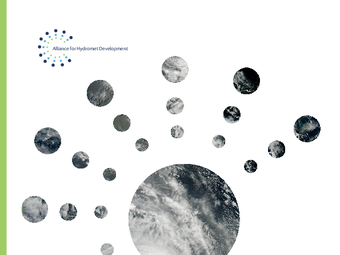Hydromet Gap Report 2021
The Alliance for Hydromet Development brings together major international development, humanitarian and climate finance institutions, collectively committed to scale up and unite efforts to close the Hydromet capacity gap by 2030. The World Food Programme (WFP), one of the partners of the Anticipation Hub, is a member of the alliance, together with the World Meteorological Organization (WMO), the Adaptation Fund, the African Development Bank, the Asian Development Bank, Climate Investment Funds, European Bank for Reconstruction and Development, Global Environment Facility, Green Climate Fund, Islamic Development Bank, United Nations Development Programme (UNDP), United Nations Environment Programme (UNEP) and the World Bank.
It aims to increase the effectiveness and sustainability of hydromet investments by forging a collaborative partnership which recognizes and leverages the respective competencies and expertise of its members. The actions of the Alliance to close the hydromet capacity gap are guided by the principles of United Nations agreements, including the Sustainable Development Goals under the 2030 Agenda for Sustainable Development, the Paris Agreement on climate change and the Sendai Framework for Disaster Risk Reduction 2015-2030. The Alliance was launched at the 25th session of the Conference of Parties (COP25) of the United Nations Framework Convention on Climate Change (UNFCCC) on 10 December 2019.
The Alliance recently launched the Hydromet Gap Report to track progress on closing the hydromet capacity gap. The report outlines how far we need to go to ensure all people have access to accurate, timely weather and climate information by 2030.
Some of the findings of the report highlight the need of additional investment in hydromet development for minimizing loss of assets, lives and impact on well-being, and for successfully planning anticipatory actions. The investments needed are related to observing systems, forecast and early warnings capabilities, communication tools, as well as to improve the ability of decision-makers to understand the information, make informed decisions, and adopt anticipatory action frameworks and post-disaster actions. The investments needed are related to observing systems, forecast and early warnings capabilities, communication tools, as well as to improve the ability of decision-makers to understand the information, make informed decisions, and adopt anticipatory action frameworks and post-disaster actions.
During the next months, the Alliance commits to: first, make a Systematic Observations Financing Facility (SOFF) operational; second, ne-tune the Country Hydromet Diagnostics (CHD) and make them a fundamental basis for SOFF support; third, continue to engage with the private sector to explore innovative and financially viable business models to close the hydromet capacity gap; fourth, explore ways to enhance the effectiveness and range of early warning systems in a more coordinated and systematic manner; and fifth to continue increasing awareness to strengthen developing countries’ hydromet capacity.
The Alliance will capture lessons learned from its scaled-up work to close the hydromet capacity gap in the second Hydromet Gap Report, envisioned for 2023.


